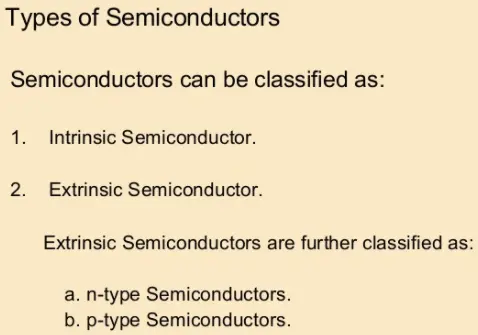Types of semiconductor


Types of Semiconductor is Provided here.
If you want to learn about semiconductor and its types, Then you are at the Right Place.
Let’s dive right in..
In terms of their electrical properties, materials can be classified into three groups:
- Conductors
- Insulators
- Semiconductors
When atoms combine to form solid, crystalline materials, they arrange themselves in a symmetrical pattern. The atoms within crystal structure are held together by covalent bonds, which are created by the interaction of the valence electrons of the atoms. Silicon is a crystalline material. All materials are made up of atoms. These atoms contribute to the electrical properties of the material, including its ability to conduct electrical current.
What is the difference between conductors and insulators?
Insulators:
An insulator is a material that does not conduct electrical current under normal conditions. Most good insulators are compounds rather than single element materials and have very high resistivities. Valence electrons are tightly bound to the atoms: therefore, there are very few free electrons in an insulator. Examples of insulators are rubber, plastics, glass, mica, and quartz.
In terms of energy bands, it means that insulators have:
- Full valence band.
- An empty conduction band.
- A large energy gap (of several e V) between them.
For conduction to take place, electrons must be given sufficient energy to jump from the valence band to the conduction band. An increase in temperature enables some electrons to go to the conduction band which fact accounts for the negative temperature coefficient of resistance of insulators.
How many types of semiconductors?
The semiconductor may be classified as under:
- Intrinsic or pure semiconductors
- Extrinsic or impure semiconductors
Intrinsic semiconductors
An intrinsic semiconductor is one that is made of the semiconductor material in its extremely pure form.
Common examples of such semiconductors are pure germanium and silicon which have forbidden energy gaps of 0.72 eV and 1.1 eV respectively. The energy gap is so small that even at ordinary room temperature, there are many electrons which possess sufficient energy to jump across the small energy gap from the valence to the conduction band. However, it is worth noting that for each electron liberated into the conduction band, a positively charged hole is created in the valence band.
When an electric field is applied to an intrinsic semiconductor at a temperature greater than 0ºK, conduction electrons move to the anode and the holes in the valence band move to the cathode. Hence, semiconductor current consists of movement of electrons and holes in the opposite direction in the conduction and valence band respectively.
Alternatively, an intrinsic semiconductor may be defined as one in which the number of conduction electrons is equal to the number of holes.
Read Also: Semiconductor Vs Superconductor
Extrinsic semiconductors
Those intrinsic semiconductors to which some suitable impurity or doping agent has been added in extremely small amounts are called extrinsic or impurity semiconductors.
Usually,the doping agents are pentavalent atoms having five valence electrons (antimony,arsenic,phosphorus,bismuth) or trivalent atoms having three valence (gallium,indium,aluminium,boron) .Pentavalent doping atom is known as the donor atom because it donates or contributes one electron to the conduction band of pure germanium. The trivalent atom, on the other hand, is called acceptor atom because it accepts one electron from the germanium atom.
Types of semiconductors (video)
Why doping material are called impurities?
The reason why doping materials are called impurities is that they alter the structure of pure semiconductor crystals.
Related Topics:
Recent Posts
Is energy quantized in classical physics?
No, according to classical wave theory the emission of electromagnetic radiations from the surface is…
Types of laser
Basically, there are four types of laser which includes: Gas Lasers Solid State lasers Liquid…
Ultrasound frequency range
What is ultrasonics? The study and application of mechanical vibrations with frequencies beyond the limits…
Electromagnetic Energy: What are some examples of it?
Electromagnetic energy definition Electromagnetic energy is the amount of energy stored in a region of…
Fundamental units and Derived Units with Examples
The Main Difference between fundamental Units and Base units is that Units that Express base…
Newton’s First law of Motion Examples in Our Daily Life
Newton's first law of motion states that " A body continues its state of rest…
View Comments